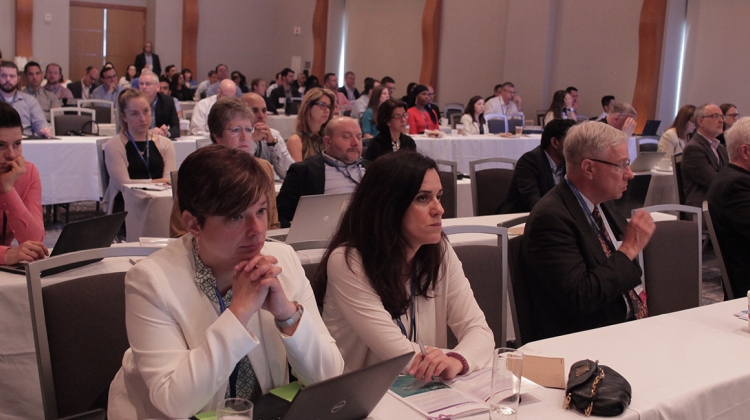The Next Wave in Biopharma Manufacturing

Innovations in production methods and technologies that enable a competitive and sustainable biopharmaceutical product supply were the focus of presentations at the 2019 ISPE Biopharmaceutical Manufacturing Conference in Boston, Massachusetts, 18–20 June. Future directions for the biopharma manufacturing industry were well represented by speakers from a range of environments.
The fast-moving biopharma industry is reaching the point where therapies will be available to more patients, and presentations at ISPE’s fourth annual Biopharmaceutical Manufacturing Conference provided ample insights into the “next wave.” Keeping the patient in mind is most important for the industry, noted conference chair Andre Walker, CPIP, Principal, Walker BioPharm Consulting.
More than 300 attendees from 168 companies and 15 countries attended to learn about innovation and the latest developments in biopharmaceutical manufacturing.
Addressing Challenges
Steve Bagshaw, CEng, FlChemE, Chief Operating Officer of Fujifilm Diosynth Biotechnologies, presented on “Advancing Tomorrow’s Medicines—Overcoming the Manufacturing Challenges Today.”
Great progress is being made, Bagshaw said. One example is AveXis’s recent FDA approval for Zolgensma, a gene therapy for pediatric patients with spinal muscular atrophy (SMA). In the US, 400 to 500 babies each year are born with SMA, and Zolgensma is a cure. AveXis has about 1 million square feet of manufacturing space in four sites, the most potential capacity of any gene therapy company, and plans to have 1,000 employees in highly skilled manufacturing roles by the end of 2019.
The dose cost for Zolgensma is $2.125 million—so the challenge of affordability remains. However, there is good news for gene therapy market growth, with steep increases projected for revenues as the number of drugs increases. Today, biotech drugs represent 25% of global pharmaceutical sales. Revenues for gene therapies are projected to climb from $10 billion in 2025 to over $20 billion by 2030. In 2019, there are 734 gene therapies; the number is projected to grow to 1,202, 2,415, and 5,476 by 2021, 2023, and 2025, respectively.
Faster growth is needed to develop and move these products forward to reach patients, Bagshaw said. Clinical trial design is changing, including flexibility in areas such as mobile cleanrooms, small bioreactors, and enclosed fill-finish units.
Today, biotech drugs represent 25% of global pharmaceutical sales.
Production “is very handmade at the moment,” he said. “Our challenge is how to turn this into an industry that you can scale up.” The challenge of what he termed “Biotechnology 4.0” is in scale-up; for example, in many cases, we don’t yet know how to get to 2,000 liters, he said. For patient groups that work with the industry, it is “devastating” to know a cure has been developed but they can’t obtain it. “Our challenge: keep up with the science and work out how to make these products in a way that we can get them to the patient.”
According to Bagshaw, viral vector manufacturing using viruses to deliver gene therapy presents its own challenges, including a highly manual manufacturing process, scale-up issues, product characterization and analytics, IT and data management, downstream processes, and upstream process issues involving tools, equipment, and technologies. Analytics needs more attention, he said, and resources and energy are being devoted to the contract world to better understand processes. Flexibility in contract development and manufacturing organizations will be key.
Needs include product platform establishment. “We’re looking for that elusive product platform that works for multiple companies,” Bagshaw said. “Getting 10 times improvement requires us to understand what we are doing,” not just what is being manufactured.
Companies are already collaborating on driving up both process and stage yield. Shorter timelines—perhaps just three or four years—are necessary, but the challenge is how to shorten them. The answer may lie with simplifying and automating processes. “One hundred times is where we need to be—not 10 times,” he said.
Bagshaw believes that major manufacturers should focus more on training a highly skilled workforce that can support the anticipated growth surge. For example, Fujifilm is partnering with Blinn College for training.
Also, collaborative initiatives with government (such as the United Kingdom’s Catapult initiative) are needed. Advanced therapies manufacturing action plans, such as the one set up in the UK, are “a really important part of the ecosystem that is part of advanced therapies,” he said, noting that the Centre for Commercialization of Regenerative Medicine in Canada is another example of this type of initiative.
Regulatory activity includes the US FDA bringing in gene therapy expertise and expanding clinical reviewer hiring to meet the anticipated needs for at least 200 investigational new drug applications each year, which are predicted to bring 10–20 cell and gene therapy approvals each year by 2025.
This activity is taking place against the backdrop of the expectation of sustainability of industry and its businesses—which is a new challenge, Bagshaw said.
Next-Wave Innovation
Jeffrey Baker, PhD, Deputy Director, Office of Biotechnology Products, Center for Drug Evaluation and Research, FDA, spoke about the impact of innovation and technology changes on bio-pharma manufacturing. In his presentation, “Pace and Sequence, Why and Why Not: Implementation of New Technology in Real-World Biopharmaceutical Manufacturing,” Baker noted that product development, assay development, and some supply chain management—rather than on-the-floor manufacturing—are to innovation and change like ripples in the water after a stone is dropped in.
Baker’s suggested the following to manage the uncertainty inherent in the biopharma field:
- Accept that uncertainty is neither good nor bad; it is merely another attribute to be understood.
- Differentiate between data analysis and knowledge management.
- Differentiate statistical thinking and statistical calculation.
- Make relevance central to risk assessment.
- Value understanding over specification.
- Optimize value rather than cost.
As an example of the uncertainty in the biopharmaceutical industry, Baker described some feedback to an “active listening session” in May 2019 with the National Institute for Innovation in Manufacturing Biopharmaceuticals (NIIMBL), a public-private partnership with more than 90 members, including 11 major pharmaceutical companies. In this discussion, NIIMBL posed the question, “With respect to the regulatory landscape, what changes would you like to see implemented that would enable your company to deploy innovative technology for manufacturing or continuous improvement?”
Baker said the key conclusion of the session was that there is rarely a business case for implementing new technologies in biopharmaceutical manufacturing. Other observations included the fact that prior to launch, new technologies pose a risk to timelines; postlaunch global change management, including maintaining separate processes for different markets, is a hurdle; and companies are generally averse to being the first to deploy a new technology in manufacturing because they believe that a sponsor may face overly burdensome hurdles during a regulatory filing.
Managing uncertainty and risk are a way of life in the biopharma industry. “It’s not about technology for the sake of technology,” Baker said. “Use technology to solve meaningful problems. You need to understand that technology is like capital—don’t expect a fast return. Don’t be fearful—but if you are, recognize it, acknowledge it, and move ahead. Brave people are scared, but they don’t let fear drive their decisions.”
Platforms for the Future

Charles L. Cooney, PhD, Robert T. Haslam (1911) Professor of Chemical Engineering, Emeritus, Department of Chemical Engineering, Massachusetts Institute of Technology, presented on “Developing Platforms for NexGen Biotherapeutics.”
The goal of pharmaceutical manufacturing is the sustained delivery of a quality (safe and efficacious) product to the patient. Achieving this objective involves both delivery to the patient and sustaining the business. Think about new platforms through the lens of technology, regulation, and business, Cooney said. The industry needs to “manage the business case without losing sight of the goal.”
Platforms serve this goal because they remove the uncertainty of technology development, permit continuous improvement, provide a framework to manage across the product life cycle, and ensure security and integrity of supply.
Cooney noted that extending a platform for delivery of differentiated products to the patient is something the industry knows how to do and continues to do better. For example, biopharma companies are delivering monoclonal antibodies (mAb) for fusion proteins, biospecific mAb, and anti-body–drug conjugates, as well as for biosimilars and biobetters. A platform built around recombinant DNA products made through genetic engineering of bacteria morphed into an extended platform for animal cells, and is now becoming the foundation for next-generation biotherapeutics.
The lessons learned from building mAb platforms should be applied to new therapeutic modalities, such as gene therapy and cell therapy. In gene therapy, these lessons are relevant to replacement and repair therapy through gene knockdown, regulation, and editing; immune regulation; gene editing; RNA therapeutics (siRNA, mRNA); and microbiome. In cell therapy, the lessons may apply to replacement or repair and regenerative medicine. “We can do it in the lab, can establish proof of concept—but can we manage repeating ourselves,” which the industry can do with mAb?
Cooney described what is needed to enable, grow, and sustain a platform, including integration into a business model, analytical methods supporting performance metrics, standards supported by a large body of published literature, regulatory guidelines across global markets, a network of technology providers, and a network of users.
He suggested these core principles in a vision for advanced manufacturing:
- Manufacturing is on a critical path between science and the patient.
- Markets will be smaller volume with uncertain demand. Supply must be adequate by indication and geography.
- Regulatory guidelines provide the grammar and vocabulary for communication across the value chain.
- Safety and efficacy, also known as quality, are sacrosanct.
- Profit from product sales must support business continuity and future product development.
Viral Vectors and More
Richard O. Snyder PhD, Vice President, Science and Technology, Pharma Services, Thermo Fisher Scientific, presented on “Viral Vectors for Cell and Gene Therapies: From Research to Commercial Production.” He described the viral vector’s role in in vivo gene therapy and gave some background about progress with this technology as well as the work that Thermo Fisher is doing.
The gene therapy landscape is maturing rapidly, Snyder said. Many participants are joining, and both regulatory expectations and industry practices to meet those expectations are advancing. The sector is unique, he said, for several reasons related to speed, bespoke facilities, and market dynamics.
Speed
- The first-in-human to biologics license application (BLA) occurred in less than four years.
- Early process lock is driving high-volume demand.
- Regulators are highly engaged, with the potential for one-and-done treatment.
- Manufacturing is increasingly important due to cost and complexity.
Bespoke Facilities
- Such facilities can’t use vast biologics capacity.
- Instead, they have dedicated suites with platform processes (change transgene).
- They are also complex facilities with regard to vector type and manufacturing platform.
- They reflect the desire of manufacturers to secure preapproval commercial capacity.
Market Dynamics
- Existing biologics innovators are switching to gene therapy.
- Large biopharma companies are outsourcing multiple technologies.
- High pricing reflects reimbursement and ramp-up uncertainty.
- The industry faces a new supply chain paradigm (high product demand in early years and high incidence rate in later years).
Snyder discussed the recombinant viral gene transfer vectors and their progress, including the retroviral/lentiviral vectors that debuted in 2016–2017 (Strimvelis, Kymriah, Yescarta, and Zynteglo) and recombinant adeno-associated viral vectors developed between 2012 and 2019 (Glybera, Luxturna, and Zolgensma).
He talked about manufacturing strategy considerations for large-scale versus small-scale lot sizes. These included (a) the manufacturing platform choice and the frequency of production, (b) rapid proof of concept in humans using a quick, small-scale approach that is followed by new process establishment and product comparability at later phases, (c) upfront commercial-destined process development and establishment for an uninterrupted path to commercial launch, and (d) considerations related to owning and/or licensing manufacturing reagents (for portability versus reliance on another provider), including choice of cell lines and starting materials.
Transformation Ahead
John G. Cox, Executive Chairman, Torque Therapeutics, spoke about “The Transformation of Bioprocessing—Past, Present, and Future.” Cell and gene therapies present a whole new set of challenges for bioprocessing engineers, Cox said. “We’ve got to figure out how to make those modalities have the impact on mankind that monoclonals [and others] have had,” he said. The biotechnology industry’s creation involved a first revolution (molecular and cellular biology) and second revolution (genomics). The next revolution has begun with the “explosion” of new biologic therapeutic modalities, including gene therapy; gene editing; cellular therapy; recombinant proteins, mAb, and fusion proteins; RNAi, mRNA, and oligonucleotides; nanobodies; and novel delivery models such as nanoparticles.
Engineering’s role in the first two revolutions has been in biotechnical engineering to transform yields, process engineering to transform throughput, and “dominant design” for robust scale-up. “There used to be a dominant design: stainless steel, great engineering, pretty much the same plant layout,” Cox noted. However, manufacturing is changing with the developments in the third revolution. Since 2015, the industry has started to see shared capacity; in 2015, Biogen had multiple plants with bioreactor capacity of about 200,000 liters.
In the third revolution, bioprocessing is being transformed. While yield has been a factor in the first, second, and third revolutions, the supply shortages of the first two revolutions are giving way to supply integration with treatment centers. Where scale-up robustness was a feature of the first and second revolutions, scale-down is an aspect of the third. The first and second revolutions had large centralized capital investments, whereas the third revolution features miniaturization/point-of-care distribution. Throughput was key in the first and second revolutions; processing speed is crucial in the third. Quality remains a constant, but the emphasis on the cost of goods in the first and second revolutions is giving way to a focus on the cost of treatment in the third.
“The industry is being changed by these new therapeutic modalities, and the diversity of these is challenging.” Nevertheless, the third revolution provides exciting opportunities. “Instead of slowing disease progression, now we are talking about curing diseases!” The challenge remains to make these therapies cost-effective and affordable.
Disclaimer
This article includes an abridged, unofficial summary of an FDA regulator’s presentation. It has not been vetted by the agency. The article offers an in-formal and brief synopsis of the FDA regulator’s views and does not represent official guidance or policy of the FDA.
Acknowledgments
Thanks to Andre Walker for his assistance with coverage of the 2019 ISPE Biopharmaceutical Manufacturing Conference.






